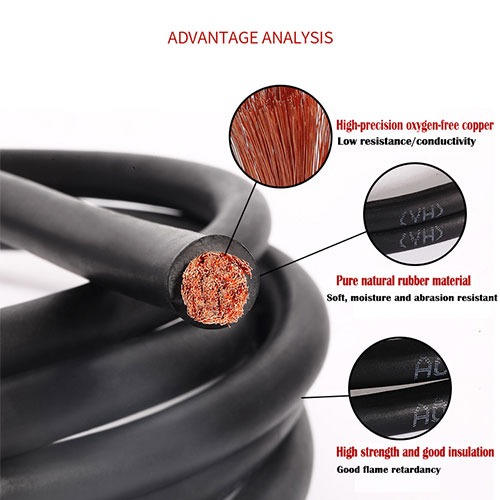How to Extend the Life of Welding Cables
Welding cables are essential components in the welding process, providing the necessary power for various welding applications. Proper care and maintenance can significantly extend the life of these cables, ensuring optimal performance and safety. In this blog post, we’ll explore effective strategies to extend the life of welding cables, delve into the latest technological innovations, and examine current market trends and prospects.
10/18/20243 min read


How to Extend the Life of Welding Cables
1. Regular Inspection and Maintenance
One of the best ways to extend the life of your welding cables is through regular inspection. Look for signs of wear, such as fraying, cracks, or abrasions. Inspect both the cable and its connectors. Any damage should be addressed immediately to prevent further issues.
2. Proper Storage
When not in use, store welding cables properly to avoid unnecessary damage. Cables should be coiled loosely and kept away from extreme temperatures and moisture. Using a cable reel or hanging them can help prevent kinks and tangles that may lead to damage.
3. Avoid Overheating
Welding cables can overheat due to excessive current draw. Ensure that the cables you’re using are rated for the current you require. If you notice cables becoming excessively hot during use, it may indicate that they are undersized for your application. Always monitor the temperature of your cables and take breaks if needed.
4. Use the Right Length of Cable
Longer cables can lead to voltage drops, which may affect the performance of your welding equipment. Use the shortest cable possible that still allows you to reach your work area. This not only improves efficiency but also reduces wear and tear on the cable.
5. Maintain Cleanliness
Dirt, oil, and other contaminants can degrade the insulation of welding cables over time. After each use, clean your cables with a damp cloth to remove any debris. Keeping them clean helps maintain their flexibility and performance.
6. Safe Handling Practices
Always handle welding cables with care. Avoid dragging them across rough surfaces or allowing them to get pinched in equipment. Safe handling practices can prevent physical damage and extend the life of your cables.
The Latest Technological Innovations in Welding Cables
The welding industry is constantly evolving, with new technologies emerging to enhance performance and safety. Here are some of the latest innovations in welding cables:
1. Advanced Insulation Materials
New insulation materials, such as thermoplastic elastomers (TPE), are becoming more common in welding cables. These materials offer superior resistance to heat, chemicals, and abrasion, extending the life of the cables while improving flexibility and performance.
2. Smart Cables
Innovations in smart technology have led to the development of “smart” welding cables that can monitor performance in real-time. These cables can track temperature, current load, and even provide alerts for potential issues, allowing for proactive maintenance and improved safety.
3. Eco-Friendly Cables
With a growing emphasis on sustainability, manufacturers are producing eco-friendly welding cables made from recyclable materials. These cables maintain high performance while reducing environmental impact, appealing to a more environmentally conscious market.
4. Enhanced Durability
Recent advancements in manufacturing processes have led to welding cables with improved durability. New designs are focused on reducing wear from frequent movement and exposure to harsh conditions, making them ideal for industrial applications.
Market Trends and Prospects of Welding Cables
The welding cable market is evolving, driven by technological advancements and changing industry needs. Here are some current trends and future prospects:
1. Increased Demand for Automation
As industries increasingly adopt automation, the demand for high-performance welding cables is rising. Automated welding processes require cables that can handle higher currents and provide consistent performance. This trend is likely to continue as manufacturers seek to improve efficiency.
2. Growth in Renewable Energy Sector
The renewable energy sector, particularly solar and wind energy, is seeing a surge in demand for welding cables. As infrastructure for renewable energy expands, so does the need for reliable and durable welding solutions.
3. Focus on Safety Regulations
With heightened awareness of safety standards, there is an increasing focus on using high-quality welding cables that comply with industry regulations. This trend is expected to drive demand for cables with advanced features, such as enhanced insulation and smart technology.
4. Emerging Markets
Emerging economies are witnessing growth in the manufacturing and construction sectors, leading to an increased demand for welding cables. As these markets expand, manufacturers are likely to focus on providing cost-effective solutions that meet the specific needs of local industries.
Conclusion
Extending the life of welding cables is essential for ensuring safety and efficiency in welding applications. By following proper maintenance practices and being aware of the latest technological innovations, welders can significantly enhance the performance and longevity of their cables.
As the welding cable market continues to evolve with new technologies and changing industry demands, staying informed about current trends can help you make the best choices for your welding needs. Whether you’re a seasoned professional or just starting, understanding how to care for and select welding cables is key to achieving successful results in your projects. Investing in high-quality welding cables not only improves performance but also contributes to a safer and more efficient working environment.
